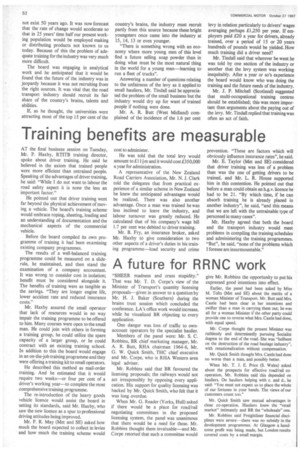Training benefits are measurable
Page 54

If you've noticed an error in this article please click here to report it so we can fix it.
AT the final business session on Tuesday, Mr. P. Haxby, RTITB training director, spoke about driver training. He said he believed in the axiom that trained people were more efficient than untrained people. Speaking of the advantages of driver training, he said: "While I do not want to labour the road safety aspect it is none the less an important factor."
He pointed out that driver training went far beyond the physical achievement of moving a vehicle. The board's training scheme would embrace roping, sheeting, loading and an understanding of documentation and the mechanical aspects of the commercial vehicle.
Before the board compiled its own programme of training it had been examining existing company programmes.
The results of a well-balanced training programme could be measured on a sliderule, he maintained, and then stand the examination of a company accountant. It was wrong to consider cost in isolation; benefit must be considered alongside it. The benefits of training were as tangible as the savings. "They are longer engine life, lower accident rate and reduced insurance costs."
Mr. Haxby assured the small operator that lack of resources would in no way impair the training programme to be offered to him. Many courses were open to the small man. He could join with others in forming a training group, he could utilize the spare capacity of a larger group, or he could contract with an existing training school. In addition to this the board would engage in an on-the-job training programme and they were offering a training kit to small operators.
He described this method as mail-order training. And he estimated that it would require two weeks—or four per cent of a driver's working year—to complete the most comprehensive training programme.
The re-introduction of the heavy goods vehicle licence would assist the board in setting its standards, said Mr. Haxby, who saw the new licence as a spur to professional driving attitudes being improved.
Mr. P. R. May (Met and SE) asked how much the board expected to collect in levies • and how much the training scheme would cost to administer.
He was told that the total levy would amount to £11+m and it would cost £350,000 a year for administration.
A representative of the New Zealand Road Carriers Association, Mr. N. J. Clark told the delegates that from practical experience of a similar scheme in New Zealand he knew the anticipated advantages would be realized. There was also another advantage. Once a man was trained he was less inclined to leave the industry, and labour turnover was greatly reduced. He calculated that of his company's wage bill 1.7 per cent was debited to driver training.
Mr. B. Fry, an insurance broker, asked Mr. Haxby to give consideration to two other aspects of a driver's duties in his training programme—load security and crime prevention. "These are factors which will obviously influence insurance rates", he said.
Mr. E. Taylor (Met and SE) considered that driver training was less of a problem than was the one of getting drivers to be trained, and Mr. L. R. House supported him in this contention. He pointed out that before a man could obtain an h.g.v. licence he had to be 21. "By which time, if he can absorb training he is already placed in another industry", he said, "and this means that we are left with the untrainable type of personnel in many cases".
Mr. Haxby agreed that both the board and the transport industry would meet problems in compiling the 'raining schedules and administering the training programmes. "But", he said, "none of the problems which I foresee are insurmountable."






















































































































